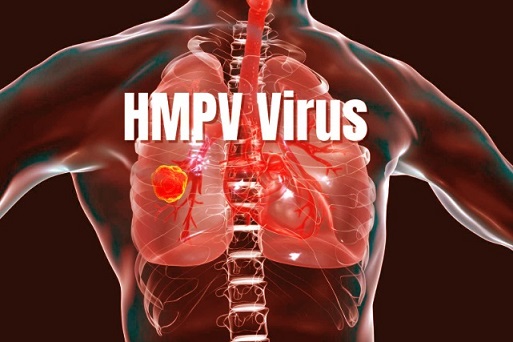Nikhil Prasad Fact checked by:Thailand Medical News Team Jan 03, 2025 4 months, 5 days, 21 hours, 5 minutes ago
Medical News: Human metapneumovirus (HMPV), a significant cause of respiratory illnesses globally, has long puzzled scientists due to its ability to evade immune defenses and reinfect individuals throughout their lifetimes. Despite its widespread impact, a licensed vaccine for HMPV remains elusive. A groundbreaking study by researchers from Vanderbilt University School of Medicine, Children’s Mercy Hospital in Kansas City, and the University of Pittsburgh School of Medicine sheds light on the mechanisms by which HMPV impairs lung CD8 T cells, the immune system’s vital soldiers in clearing infections.
 Human Metapneumovirus (HPMV) Impairs Lung CD8 T Cells
The Critical Role of CD8 T Cells in Immunity
Human Metapneumovirus (HPMV) Impairs Lung CD8 T Cells
The Critical Role of CD8 T Cells in Immunity
CD8 T cells, a subset of white blood cells, are crucial in combating viral infections. When a virus invades, these cells identify and destroy infected cells, preventing the spread of the virus. However, as this
Medical News report delves into, the effectiveness of these cells can be significantly compromised during HMPV infection. Researchers discovered that the virus’s interaction with these immune cells leads to a functional impairment, limiting their ability to respond effectively to subsequent infections.
This research primarily focused on understanding how HMPV interacts with CD8 T cells in the lungs. Utilizing animal models, the study revealed that while HMPV-specific CD8 T cells are initially functional, their effectiveness diminishes rapidly post-infection. This functional impairment is linked to the expression of inhibitory receptors such as programmed death-1 (PD-1), which regulates immune responses but can suppress T cell activity when overexpressed.
Key Findings of the Study
The study, led by a team of scientists from the Department of Pathology, Microbiology, and Immunology at Vanderbilt University, demonstrated several key points:
-Impairment Despite Vaccination
The researchers developed virus-like particles (VLPs) containing HMPV’s fusion (F) and matrix (M) proteins. These VLPs, designed to mimic the virus without causing infection, successfully elicited CD8 T cell responses in vaccinated mice. However, when the animals were exposed to live HMPV, their lung CD8 T cells exhibited the same level of impairment as those from unvaccinated mice. This highlights a critical challenge in developing vaccines capable of maintaining functional T cell immunity in the lungs.
Inhibitory Receptors and T Cell Dysfunction
The study found that CD8 T cells in the lungs expressed high levels of PD-1 and other inhibitory receptors during HMPV infection. These markers are associated with “exhausted” T cells that lose their ability to respond effectively to antigens. Notably, while CD8 T cells in the spleen remained functional, those in the lungs were significantly impaired, emphasizing the localized impact of the virus on lung immunity.
Role of Vaccine Design
While the VLP vacc
ine elicited robust CD8 T cell responses, the researchers observed a key limitation: the vaccine did not prevent the virus from inducing T cell impairment upon challenge. This suggests that while vaccines can stimulate an immune response, the underlying mechanisms of T cell dysfunction caused by HMPV remain unresolved.
Long-term Implications for Vaccine Development
The study’s findings underline the complexity of designing vaccines for respiratory viruses like HMPV. Current strategies focusing solely on antibody responses may be insufficient. The ability of HMPV to impair lung CD8 T cells despite prior immunization raises concerns about the effectiveness of traditional vaccine approaches in achieving durable immunity.
Broader Implications
The findings have broader implications for understanding respiratory viral infections, including those caused by related pathogens like respiratory syncytial virus (RSV). Both viruses share similarities in their ability to evade immune responses and reinfect individuals. The study’s insights into CD8 T cell impairment could pave the way for innovative therapeutic approaches that target the mechanisms of T cell exhaustion.
Conclusions
This study provides critical insights into the immune evasion strategies employed by HMPV. By impairing lung CD8 T cells, the virus not only ensures its survival during the initial infection but also sets the stage for future reinfections. The research underscores the need for a dual-pronged approach in vaccine development that addresses both antibody production and T cell functionality.
The findings suggest that overcoming inhibitory receptor expression, particularly PD-1, could be a key strategy in designing effective vaccines or therapies for HMPV and similar respiratory viruses.
Ultimately, this research highlights the resilience of HMPV and the challenges it poses to the immune system. While vaccines like the VLP-based approach show promise, further studies are needed to fully address the mechanisms of T cell impairment and achieve comprehensive protection against this formidable pathogen.
The study findings were published in the peer-reviewed Journal of Virology.
https://journals.asm.org/doi/10.1128/jvi.00670
For the latest HMPV News, keep on logging to Thailand
Medical News.
Read Also:
https://www.thailandmedical.news/news/human-metapneumovirus-hmpv-can-cause-neurologic-issues
https://www.thailandmedical.news/news/louisiana-study-finds-that-human-metapneumovirus-uses-mirnas-to-impair-immune-responses-involving-interferons
https://www.thailandmedical.news/news/human-metapneumovirus-hmpv-alters-actin-cytoskeleton-of-host-cells-to-enhance-direct-cell-to-cell-spread
https://www.thailandmedical.news/articles/hmpv-human-metapneumovirus
